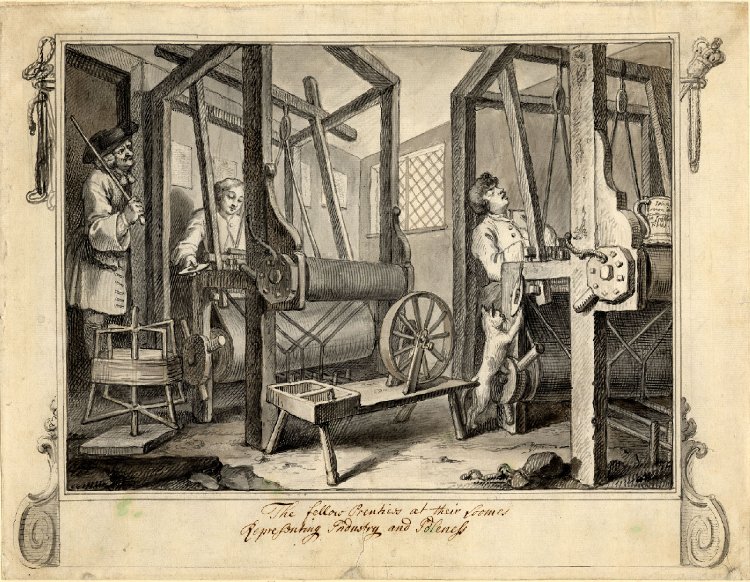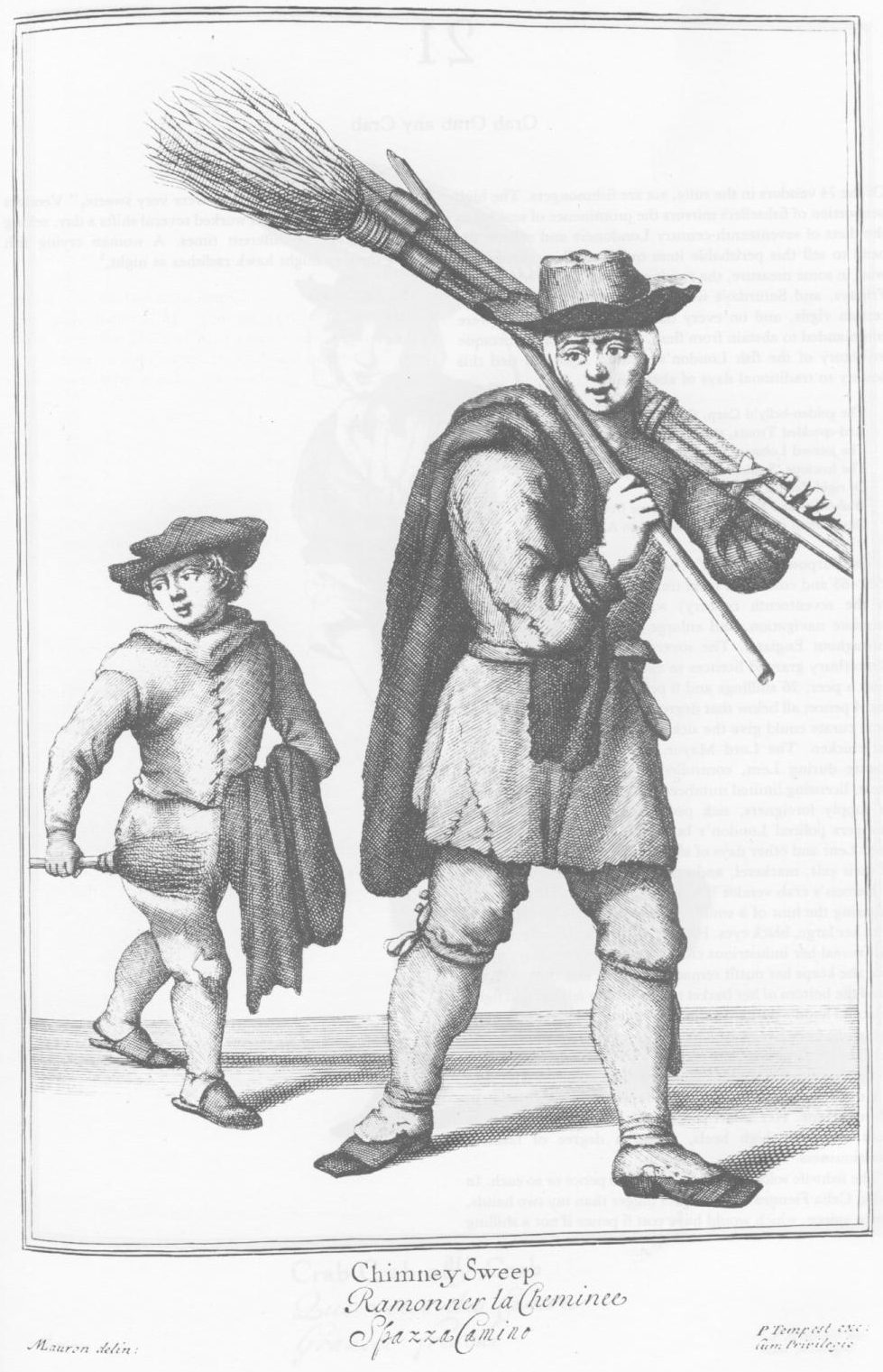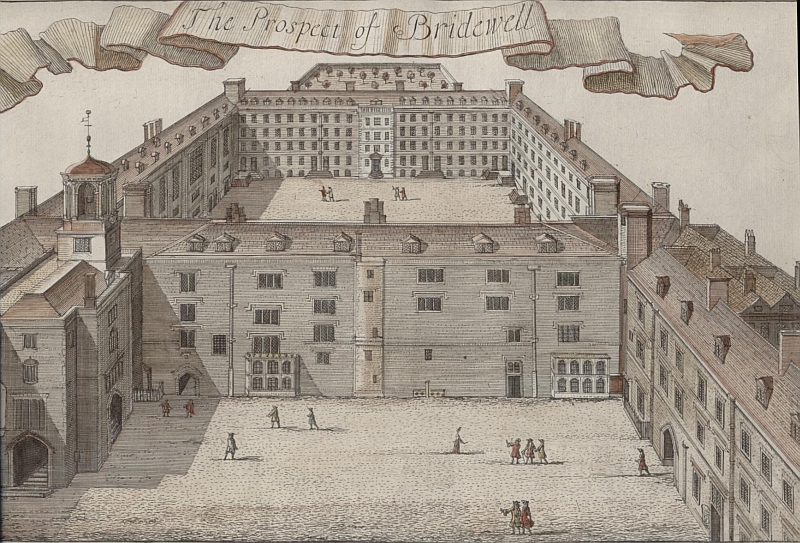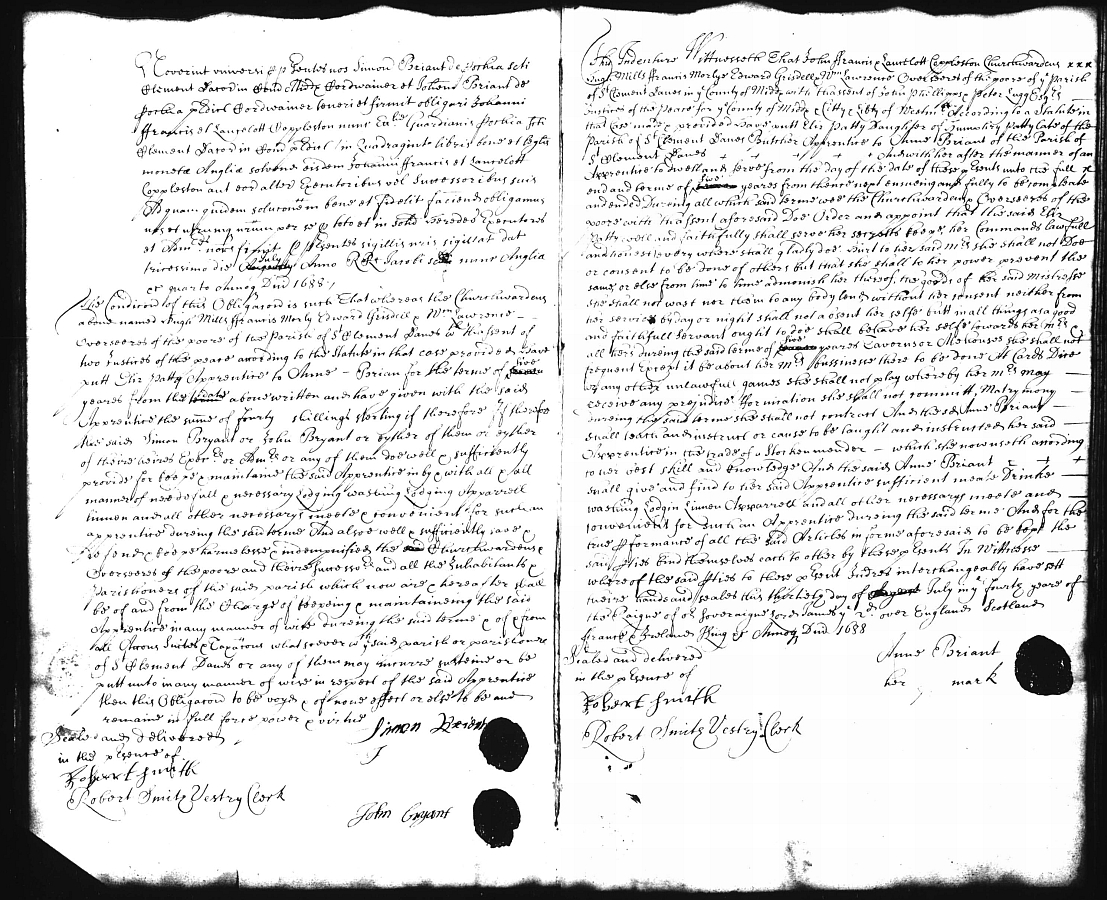Researching Apprentices
 William Hogarth. Finished Drawing for Plate 1 of Industry and Idleness (1747), The fellow 'prentices at their looms. British Museum, Binyon 1, Croft-Murray (unpublished) 25, Oppe 41. © Trustees of the British Museum.
William Hogarth. Finished Drawing for Plate 1 of Industry and Idleness (1747), The fellow 'prentices at their looms. British Museum, Binyon 1, Croft-Murray (unpublished) 25, Oppe 41. © Trustees of the British Museum.
Introduction
London Lives includes a wide range of documents which provide evidence about apprentices, including the legal process of binding an apprentice, the regulation of apprenticeships, the experience of apprenticeship itself, and the lives of apprentices following completion of their apprenticeships. Significant bodies of material are located in the records of the parishes, Bridewell Hospital and Prison, the sessions, and the Carpenters' Company, while references to apprentices can also be found scattered throughout the criminal records.
Parish Apprentices
The practice of parishes binding poor boys and girls to masters in order to learn a trade was widespread, and evidence can be found throughout parish records. The parochial document types specifically concerned with apprenticeship are:
- Indentures of Apprenticeship (IA). An indenture was the legal document which formed the agreement between master and apprentice, stipulating the obligations of each party. These were formulaic documents, but they do provide evidence of the identities of both parties and the nature of the trade the apprentice was expected to learn. This website includes indentures from all three of the core parishes. Those for the parish of St Botolph Aldgate are available from 1691 to 1700. A separate record series, a register of Indemnities and Indentures (PA), provides similar records for the parish of St Clement Danes for the period from 1688 to 1694. Indentures for the parish of St Dionis Backchurch can be found in the Miscellaneous Papers (PM).
- Resisters of Pauper Apprenticeships (RA). Following the passage of the Act for the Better Regulation of the Parish Poor Children in 1767, parishes were required to keep a register of the apprentices they placed with masters, in order to ensure the provisions of the law were carried out. Each entry in these registers includes the name of the apprentice, their age, when they were placed apprentice, the name, trade and location of the master or mistress, the period of the apprenticeship, and the fee paid. These apprentices are also listed in Registers of Poor Children (RC), where they are cross-referenced to the Registers of Pauper Apprenticeships. For the parish of St Clement Danes, there is a very similar record series, the Alphabetical Registers of Pauper Apprenticeships (PA).
 Chimney Sweep, Marcellus Laroon, The Cryes of London, 1679. © London Lives.
Chimney Sweep, Marcellus Laroon, The Cryes of London, 1679. © London Lives.
Other parish records which include frequent references to pauper apprentices include:
- Churchwardens' Account Books (AC), Miscellaneous Account Books (AO), Minutes of Churchwardens and Overseers of the Poor (MO), and Vestry Minutes (MV) all contain records of parish officers' decisions, and the associated costs, concerning binding out parish apprentices (sometimes including apprentices' names and the names of their masters and mistresses).
- Parish Clothing Books (BC) and (BN) record clothing distributed to children who were put out as parish apprentices.
- Workhouse Registers (RW). Young workhouse inmates were often discharged into parish apprenticeships. Similar evidence is found in the Workhouse Inquest Minute Books (IW) of St Dionis Backchurch and the St Martin in the Fields Workhouse Registers.
- Churchwardens' Vouchers and Receipt Books (PP). These miscellaneous papers for the parish of St Dionis Backchurch include many examples of the records listed above.
Paupers were also bound out by charities as apprentices. The Marine Society sent poor boys aged 12-18 to merchant ships. The Society's registers provide the names and dates boys entered into apprenticeship indentures, but the database does not indicate to whom they were apprenticed. This information, however, can be found in the original registers, kept at the National Maritime Museum.
Bridewell Apprentices
In addition to a prison for the disorderly poor, Bridewell was a hospital which provided apprenticeships teaching craft skills for deserving children. Evidence of the identities and experiences of these apprentices can be found in the following records:
- Registers of Apprentices (RA), available from 1784, list the names of boys who were nominated for apprenticehips. For each boy, the following information is given: name, age, parent's name, trade and residence, the name of the trade applied for, the name of the nominating governor and date, and the name of the master allocated, if any. In some cases the application was "refused", the boy was labelled "too old", or the register simply lists "provided for", without indicating how.
 The Prospect of Bridewell from John Strype, An Accurate Edition of Stow's Survey of London (1720). © Tim Hitchcock.
The Prospect of Bridewell from John Strype, An Accurate Edition of Stow's Survey of London (1720). © Tim Hitchcock.
- Register of Disciplinary Cases (IA) concerning apprentices, 1710-1794, indicating for each entry the date, name of apprentice and their master, the offence, and any punishments or sanctions, with space for any subsequent delinquencies to be added should they have occurred.
- Minutes of the Court of Governors (MG), 1689-1800. Among the business of the court of governors documented here are the admission of new apprentices, decisions on disciplinary cases, decisions to award the freedom of the City to those who successfully completed their apprenticeships, and responses to petitions from former apprentices who requested assistance from the charity known as Lock's Gift.
- Minute Books of the Prison Committee and Sub-Committee (MB), 1775-1801. These include records of decisions taken on accommodation and furniture, problems concerning individual apprentices, and discussions over an unsuccessful proposal to abolish the Bridewell apprenticeships. The second and third volumes include an indication of the number of apprentices who were in Bridewell each time the committee met.
Back to Top | Introductory Reading
Guild and Hospital Apprentices
In addition to a form of charity, apprenticeship also continued to function in the eighteenth century as a means of training the boys (and a few girls) of wealthier parents, with the apprenticeships recorded and regulated by the guilds.
London Lives does not include apprentice registers for the one guild included, the Carpenters' Company, but the Company's Court of Assistants Minute Books (MC) include the names of apprentices bound to members of the Company, those who transferred masters when their masters died or the indenture was dissolved, and those who were made free of the Company on the completion of their service.
One of the places apprentices in the medical profession worked was in hospitals, including St Thomas's Hospital. Records of decisions taken by the governors and grand committee of St Thomas's with respect to apprentices who worked with the hospital's surgeons can be found in the Court of Governor's Minute Books (MG) and the Court/Committee Minute Books (MC).
Disputes
Many apprenticeships were broken by the death or bankruptcy of the master or mistress, or by the apprentice through absconding. Relations between apprentices and their masters also broke down owing to mistreatment by the master or his failure to provide appropriate subsistence or training, and when apprentices stole from their masters or otherwise misbehaved. It required an order from a Justice of the Peace for an indenture to be legally cancelled, following a petition from the master or his apprentice (or their parent). The Sessions Papers (PS) contain numerous documents concerning such cases, including petitions, original indentures, and records of Justices' decisions. Within the City of London, disputes were taken to the Mayor's Court or the Chamberlain's Court, the records of which are not included on this website, but are available at the London Metropolitan Archives.1
 St Clement Danes, Apprenticeship Records, 1688-1694, Westminster Archives Centre, Ms.B1270, LL ref: WCCDPA364000113&14.
St Clement Danes, Apprenticeship Records, 1688-1694, Westminster Archives Centre, Ms.B1270, LL ref: WCCDPA364000113&14.
The Experience of Apprenticeship and After
Incidental information about apprentices can be found in a number of sources. The index to the Prerogative Court of Canterbury Wills, for example, includes forty-three testators identified as apprentices. The existence of apprentices is frequently included in the Poll Tax Assessments, but they are rarely named.
For evidence about apprentices' lives following the completion of their apprenticeships two types of sources are particularly useful. Pauper Examinations (EP), conducted to establish the settlement of paupers and vagrants, routinely include information about whether, and if so where, to whom, and for how long, the examinee had served as an apprentice (often decades earlier). See also the St Martin in the Fields Settlement Examinations and the similar record series for St Clement Danes, the Register of Passes (RD). Similarly, past apprenticeships figure in the short biographies in the List of Persons in the St Clement Danes Workhouse (LW) in 1785, which provide explanations of how the inmates came to have a settlement in the parish.
The other especially useful source is the Ordinary's Accounts (OA), biographies of the convicts executed at Tyburn. Over 40 per cent of these condemned convicts in the first half of the eighteenth century had been apprenticed to a trade (though many did not complete their apprenticeships),2 and the Ordinary's narratives provide valuable evidence of the role of apprenticeship in the lives of the working poor.
Apprentices appear frequently in the criminal records, but this is probably simply because young people dominate the ranks of the accused, and so many young people spent time as apprentices. As recorded in the Old Bailey Proceedings, between 1690 and 1800 hundreds of the defendants tried for felonies were identified as apprentices. As with other defendants, the vast majority were charged with various types of theft (in this case, often from their masters), though some were charged with more serious offences, including murder and coining. The much smaller number of apprentices identified as victims of crime, however, were disproportionately likely be the victims of murder, rape, sodomy, and highway robbery, reflecting the vulnerability of youth. In addition to the Old Bailey Proceedings, valuable evidence about these crimes can be found in the Sessions Papers (PS).
Beyond details of their crimes, many of these documents, particularly the Old Bailey Proceedings, include valuable incidental information about apprentices' lives more generally, since apprentices frequently served as witnesses. Between 1690 and 1800 almost two thousand trial accounts in the Proceedings include the word "apprentice". Coroners' Inquests (IC) provide evidence concerning the lives of a small number deceased apprentices, as well as testimonies from a larger number of witnesses identified as apprentices.
Questioning the Archive
- In what circumstances did parishes bind their pauper children out as apprentices? Was this an effective means of preparing them to earn their own livelihood, so that they would no longer be a burden on the parish?
- Under what circumstances were the relationships between masters and their apprentices most likely to break down?
- What impact did apprenticeship have on a child's subsequent life chances? Was it a form of upwards (or downwards) social mobility?
- Why did so many criminals have a background as apprentices?
- Did apprenticeship continue to be a useful means of learning a trade in the eighteenth century?
- What trades could girls enter as apprentices?
Back to Top | Introductory Reading
Exemplary Lives
Lives using the keyword Apprentice:
Lives using the keywords Bridewell Apprentice:
Lives using the keywords Parish Apprentice:
Introductory Reading
- Ben-Amos, Ilana. Adolescence and Youth in Early-Modern England. New Haven, 1994.
- Brooks, C. W. Apprenticeship, Social Mobility and the Middling Sort. In Barry, J. and Brooks, C. W., eds, The Middling Sort of People. Basingstoke, 1994, pp. 52-83.
- Linebaugh, Peter. The London Hanged: Crime and Civil Society in the Eighteenth Century. 1991.
For further reading on this subject see the London Lives Bibliography
Footnotes
1 Drew D. Gray, Crime, Prosecution and Social Relations: The Summary Courts of the City of London in the Late Eighteenth Century (Basingstoke, 2009), pp. 16, 160-66. ⇑
2 Peter Linebaugh, The London Hanged: Crime and Civil Society in the Eighteenth Century (1991), p. 101. ⇑